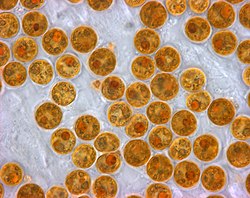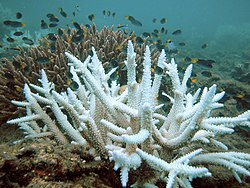Coral bleaching
Coral bleaching occurs when stony corals turn white.
Stony corals are simple animals that form large reefs. The animals live in a endosymbiotic relationship with single-celled algae. To get sunlight the corals live just below sea level. The algae make food products for the coral polyp by photosynthesis.[1]
Coral polyps are sensitive to changes in their environment. This includes the temperature of the water they live in. Under stress, coral polyps may expel the algae which live inside their tissues. The algae provide up to 90% of the coral's energy. Bleached corals continue to live but begin to starve after bleaching.[2] Some corals recover.
Warmer sea water temperatures caused by global warming is the leading cause of coral bleaching.[2]
The United Nations Environment Programme says that the longest recorded global bleaching events happened between 2014 and 2016. Coral was killed on an unprecedented scale. In 2016, bleaching of coral on the Great Barrier Reef killed between 29 and 50 percent of the reef's coral.[3][4][5] In 2017, the bleaching got into the central region of the reef.[6][7] The interval between bleaching events has halved between 1980 and 2016.[8]
Recent research showed that the coral-algae relationship is much older than was thought. This suggests it has survived many climate changes.[9]
Some corals change color instead of turning white when they are bleached. The colors can be very bright. In May 2020, scientists from the University of Southampton said that the colors act like sunscreen and protect the coral cells from light. The scientists said this means some corals can lose their algae for a while and might have developed bright colors as a way to make it easier for the algae to come back and to stay alive until then.[10][11]
Coral Bleaching Media
Climate change will affect coral reef ecosystems, through sea level rise, changes to the frequency and intensity of tropical storms, and altered ocean circulation patterns. When combined, all of these impacts dramatically alter ecosystem function, as well as the goods and services coral reef ecosystems provide.
Zooxanthellae, the microscopic algae that lives inside coral, gives it colour and provides it with food through photosynthesis
Bleached Acropora coral with normal coral in the background
Two images of the Great Barrier Reef showing that the warmest water (top picture) coincides with the coral reefs (lower picture), setting up conditions that can cause coral bleaching.
References
- ↑ Dove S.G. & Hoegh-Guldberg O. et al. (2006). "Coral bleaching can be caused by stress. The cell physiology of coral bleaching". In Ove Hoegh-Guldberg (ed.). Coral reefs and climate change: science and management. [Washington]: American Geophysical Union. pp. 1–18. ISBN 0-87590-359-2.
{{cite book}}: CS1 maint: uses authors parameter (link) - ↑ 2.0 2.1 (in en-GB) The Great Barrier Reef: a catastrophe laid bare. 2016-06-06. . https://www.theguardian.com/environment/2016/jun/07/the-great-barrier-reef-a-catastrophe-laid-bare. Retrieved 2016-10-15.
- ↑ "Coral bleaching on Great Barrier Reef worse than expected, surveys show". The Guardian. 29 May 2017. https://www.theguardian.com/environment/2017/may/29/coral-bleaching-on-great-barrier-reef-worse-than-expected-surveys-show. Retrieved 29 May 2017.
- ↑ "The United Nations just released a warning that the Great Barrier Reef is dying" (in en-GB). The Independent. 2017-06-03. https://www.independent.co.uk/news/world/australasia/great-barrier-reef-unesco-coral-bleaching-dead-dying-a7770531.html. Retrieved 2017-06-11.
- ↑ Hughes T.P. et al. (2017). "Global warming and recurrent mass bleaching of corals". Nature. 543 (7645): 373–377. Bibcode:2017Natur.543..373H. doi:10.1038/nature21707. hdl:20.500.11937/52828. PMID 28300113. S2CID 205254779.
{{cite journal}}: CS1 maint: uses authors parameter (link) - ↑ "Mass coral bleaching hits the Great Barrier Reef for the second year in a row" (in en). USA TODAY. 13 March 2017. https://www.usatoday.com/story/news/nation-now/2017/03/13/great-barrier-reef-mass-coral-bleaching-second-year-row/99116432/. Retrieved 2017-03-14.
- ↑ Galimberti, Katy (18 April 2017). "Portion of Great Barrier Reef hit with back-to-back coral bleaching has 'zero prospect for recovery'". AccuWeather.com. Retrieved 18 April 2017.
When coral experiences abnormal conditions, it releases an algae called zooxanthellae. The loss of the colorful algae causes the coral to turn white.
- ↑ Hughes T.P.; et al. (2018). "Spatial and temporal patterns of mass bleaching of corals in the Anthropocene" (PDF). Science. 359 (6371): 80–83. Bibcode:2018Sci...359...80H. doi:10.1126/science.aan8048. PMID 29302011. S2CID 206661455. Archived from the original (PDF) on 2022-01-28. Retrieved 2022-02-23.
- ↑ Halton, Mary 2018. Coral reefs 'weathered dinosaur extinction'. BBC News Science & Environment. [1]
- ↑ Eurekalert.org (May 21, 2020). "Mysterious glowing coral reefs are fighting to recover". Press release. https://www.eurekalert.org/pub_releases/2020-05/uos-mgc051820.php. Retrieved May 21, 2020.
- ↑ Elena Bollati; Cecilia D'Angelo; Rachel Alderdice; Morgan Pratchett; Maren Ziegler; Jörg Wiedenmann (July 6, 2020). "Optical Feedback Loop Involving DinoflagellateSymbiont and Scleractinian Host Drives ColorfulCoral Bleaching" (PDF). Current Biology. Cell. 30 (13): 2433–2445.e3. doi:10.1016/j.cub.2020.04.055. PMID 32442463. S2CID 218762967. Retrieved May 21, 2020.











